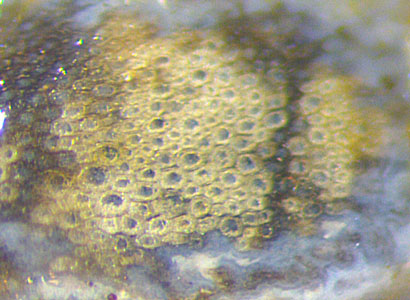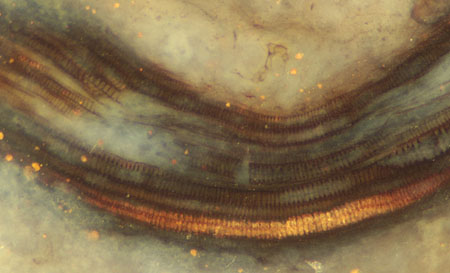Ventarura
xylem
The last discovered early
land plant in the Rhynie chert, Ventarura
[1], which is Latin for "windy field" and refers to the Windyfield farm
near Rhynie, is not abundant but also not really rare so that one may
wonder why it had been overlooked for decades, all the more so since it
can be recognised by a unique feature which remains conspicuous even in
stages of decay: It is an apparently rot-resistent fraction of tissue
shaped like a tube, seen on
cross-sections as a mostly dark concentric ring of well-preserved
cells. It had been thought to consist of sclerenchyma [1] but does not, as discussed in Rhynie
Chert News 58
[2].
Part of this peculiar dark ring, named
"middle cortex" in [1], is
distinctly seen on the raw surface of the sample in Fig.1. An
illusion of mechanical strength of the "middle cortex" arises from the
weakened or vanished "outer and inner cortex" tissue.
An outer contour deformed
by shrinkage before silicification in combination with a persistent
circular ring in the middle of the
cortex is a characteristic
feature of Ventarura
if silicified while slightly
shrivelled.
The space inside the ring
in Fig.1 had undergone several transformations. Judging from the levels at
the bottom it had been filled with water where precipitate grains
formed
suspensions which settled down into not quite distinct horizontal
layers. The larger part of the cavity became nearly filled with silica
gel grown as a coating along the walls, later turning into
chalcedony, partially stained yellow with iron oxides. The white
stain, as usual, is brought about by light
reflection from Ám-size crystallite grains in the transparent
chalcedony.
The innermost part of this stump is of particular interest
as it offers a rare sight at a xylem cross-section (Fig.2).
 Fig.1 (right): Ventarura
stump
protruding from an old fracture face in Rhynie chert, appearing as a
cross-section in top view. Note the combination of deformed contour and
circular ring which is typical for wilted Ventarura.
Fig.1 (right): Ventarura
stump
protruding from an old fracture face in Rhynie chert, appearing as a
cross-section in top view. Note the combination of deformed contour and
circular ring which is typical for wilted Ventarura.
Image width 10mm.
Fig.2 (left): Ventarura
xylem cross-section,
detail of Fig.1. Image width 0.9mm.
Ventarura
xylem
cross-sections are seldom distinctly seen. Therefore,
another example with distinctly
seen xylem, Rhynie
Chert News 91 ,
is shown here once more: Fig.3.


Fig.3 (left):
Ventarura cross-section
with well preserved xylem
and the very seldom seen epidermis on the right.
Image width 2.2mm, xylem width 0.45mm.
Fig.4 (right):
Ventarura xylem
with scalariform tracheid wall pattern.
Image width 1mm, xylem width 0.33mm, same scale
as Fig.2.
Photograph by Gerd
Schmahl
Apparently this contribution does not address one of
the many problems concerning the early land plants. It is meant to
raise interest in the unsolved problems by drawing attention to the
beauty of details like the complex stump in Fig.1 and the golden
staircase in
Fig.4. It can be assumed that pondering about the details will be
helpful in solving the real problems, as in this case, the purpose of
the persistent tube in Figs.1,3.
Samples: Rh11/94 (0.2kg), found in 2011, Part2: Figs.1,2;
Rh2/143 (0.9kg), obtained from Shanks in
2008, Part3: Fig.3;
Rh2/29 (? kg), obtained from Shanks in
2001, Part4: Fig.4;
H.-J.
Weiss
2021
[1]
C.L. Powell, D. Edwards, N.H. Trewin: A new vascular
plant from the Lower Devonian Windyfield chert, Rhynie.
Trans. Roy. Soc.
Edingurgh, Earth Sci. 90(2000 for 1999), 331-349.
[2] H.-J.
Weiss: Ventarura with
less-common features, www.chertnews.de, Rhynie Chert News 58.
 |
 |
171 |



 Fig.1 (right): Ventarura
stump
protruding from an old fracture face in Rhynie chert, appearing as a
cross-section in top view. Note the combination of deformed contour and
circular ring which is typical for wilted Ventarura.
Fig.1 (right): Ventarura
stump
protruding from an old fracture face in Rhynie chert, appearing as a
cross-section in top view. Note the combination of deformed contour and
circular ring which is typical for wilted Ventarura. 


